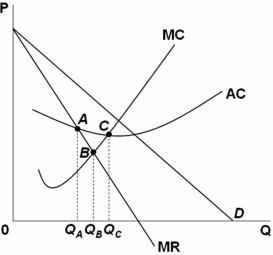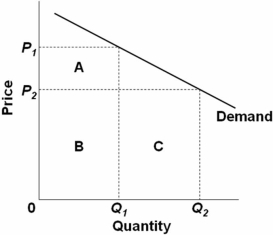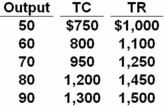Correct Answer

verified
Correct Answer
verified
Multiple Choice
Pure monopolists:
A) maximize MR.
B) are price takers.
C) sell where P > MC.
D) confront demand curves that are perfectly inelastic.
Correct Answer

verified
Correct Answer
verified
True/False
There is substantial evidence that antitrust policy has been effective in identifying and prosecuting price-fixing by businesses.
Correct Answer

verified
Correct Answer
verified
Multiple Choice
The first Federal antitrust law,passed by Congress in 1890,was the:
A) Clayton Act.
B) Federal Trade Commission Act.
C) Celler-Kefauver Act.
D) Sherman Act.
Correct Answer

verified
Correct Answer
verified
Multiple Choice
The nondiscriminating pure monopolist's demand curve:
A) is the industry demand curve.
B) shows a direct or positive relationship between price and quantity demanded.
C) tends to be inelastic at high prices and elastic at low prices.
D) is identical to its marginal revenue curve.
Correct Answer

verified
Correct Answer
verified
True/False
Price-fixing is illegal under Section 1 of the Sherman Act.
Correct Answer

verified
Correct Answer
verified
Multiple Choice
 In the figure above:
In the figure above:
A) triangle ABC represents the welfare loss to the society because of the monopoly in the market.
B) if the firm is producing an amount QC (point C) ,it is maximizing profit because MC = AC at that point.
C) point B,where MR = MC,represents the point where the difference between total revenue and total cost is the largest.
D) point A,where MR = AC,represents the point where the difference between total revenue and total cost is the largest.
Correct Answer

verified
Correct Answer
verified
Multiple Choice
Natural monopolies result from:
A) patents.
B) copyrights.
C) control over an essential natural resource.
D) extensive economies of scale in production.
Correct Answer

verified
Correct Answer
verified
Multiple Choice
 Which of the above shows the correct relationship between demand and marginal revenue?
Which of the above shows the correct relationship between demand and marginal revenue?
A) A
B) B
C) C
D) D
Correct Answer

verified
Correct Answer
verified
Multiple Choice
 Refer to the above diagram.The quantity difference between areas A and C for the indicated price reduction measures:
Refer to the above diagram.The quantity difference between areas A and C for the indicated price reduction measures:
A) marginal cost.
B) marginal revenue.
C) monopoly price.
D) a welfare or efficiency loss.
Correct Answer

verified
Correct Answer
verified
Multiple Choice
Which is an example of a privately owned monopoly?
A) The De Beers diamond syndicate
B) State of Utah Liquor Commission Stores
C) U.S.Postal Service
D) New Jersey State Lottery
Correct Answer

verified
Correct Answer
verified
Multiple Choice
At an equilibrium level of output in a pure monopoly:
A) P = MC and P = minimum ATC.
B) P = MC and P > minimum ATC.
C) P > MC and P > minimum ATC.
D) P > MC and P = minimum ATC.
Correct Answer

verified
Correct Answer
verified
Multiple Choice
The following data show the relationship between output,total costs,and total revenue for a pure monopoly  Within which of the following output ranges does the firm earn maximum economic profits?
Within which of the following output ranges does the firm earn maximum economic profits?
A) 50 to 60 units
B) 60 to 70 units
C) 70 to 80 units
D) 80 to 90 units
In output range 60-70,profit is $300.This is higher than profits in any other range.
Correct Answer

verified
Correct Answer
verified
True/False
One general policy option to deal with a monopoly that obtains its position through anticompetitive actions,exhibits economic inefficiency,and is long lasting is to break up the firm.
Correct Answer

verified
Correct Answer
verified
Multiple Choice
One feature of pure monopoly is that the demand curve:
A) is vertical.
B) is horizontal.
C) slopes upward.
D) slopes downward.
Correct Answer

verified
Correct Answer
verified
Multiple Choice
Given the same cost data,a pure monopolist producer will charge:
A) a lower price and produce a smaller output than a purely competitive industry.
B) a higher price and produce a smaller output than a purely competitive industry.
C) the same price and produce the same output as a purely competitive industry.
D) a higher price and produce a larger output than a purely competitive industry.
Correct Answer

verified
Correct Answer
verified
Multiple Choice
When compared with the purely competitive industry with identical costs of production,a monopolist will produce:
A) more output and charge the same price.
B) more output and charge a higher price.
C) less output and charge a higher price.
D) less output and charge the same price.
Correct Answer

verified
Correct Answer
verified
Multiple Choice
Any activity designed to transfer income or wealth to a particular individual or firm at society's expense is called:
A) patent protection.
B) X-inefficiency.
C) price discrimination.
D) rent-seeking.
Correct Answer

verified
Correct Answer
verified
Multiple Choice
The supply curve for a monopoly is:
A) the portion of the marginal cost curve that lies above the average variable cost curve.
B) the portion of the marginal cost curve that lies above the average total cost curve.
C) the portion of the marginal cost curve that lies above the average fixed cost curve.
D) not a curve but a single point.
Correct Answer

verified
Correct Answer
verified
Multiple Choice
Which is most characteristic of a pure monopoly?
A) There is a dominant firm in a multifirm industry.
B) The firm produces a good or a service for which there are no close substitutes.
C) The firm has considerable control over the quantity of the output produced,but not over price.
D) Exit from the industry is blocked but entry into the industry is relatively easy.
Correct Answer

verified
Correct Answer
verified
Showing 41 - 60 of 150
Related Exams